Silver ingots appearing "dark and darker" typically indicate the presence of tarnish, a chemical reaction between silver and sulfur-containing compounds in the air or other environments.
Understanding Silver Tarnish
- Composition: Tarnish is primarily composed of silver sulfide (Ag₂S).
- Cause: Sulfur compounds, such as hydrogen sulfide (H₂S) present in polluted air, react with silver on the surface of the ingot.
- Appearance: Initially, tarnish appears as a yellowish or light brown discoloration, gradually darkening to black over time.
Factors Affecting Tarnishing
- Humidity: High humidity accelerates the tarnishing process.
- Air Pollution: Areas with high levels of sulfur dioxide (SO₂) and other pollutants promote tarnish formation.
- Contact with Certain Materials: Rubber, wool, and certain foods contain sulfur compounds that can hasten tarnishing.
- Skin Contact: Sweat and oils from skin can contain sulfur compounds contributing to tarnish.
Prevention Strategies
- Storage: Store silver ingots in airtight containers or tarnish-resistant bags.
- Desiccants: Use desiccants to absorb moisture within storage containers.
- Avoidance: Minimize contact with materials known to promote tarnishing.
- Protective Coatings: Apply specialized silver protectant sprays or lacquers.
Tarnish Removal
- Commercial Cleaners: Use commercially available silver cleaning solutions designed to remove tarnish.
- DIY Methods: Employ methods such as using baking soda and aluminum foil in hot water to reverse the silver sulfide.
- Gentle Polishing: Use a soft cloth to gently polish the silver, removing the tarnish layer. Avoid abrasive cleaners.
Note: Always test cleaning methods on a small, inconspicuous area first to ensure no damage occurs. For valuable or antique silver ingots, consider professional cleaning to avoid any potential harm.











